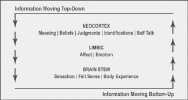According to Jean Liedloff, the continuum concept is the idea that in order to achieve optimal physical, mental and emotional development, human beings — especially babies — require the kind of experience to which our species adapted during the long process of our evolution. For an infant, these include such experiences as...
*constant physical contact with his mother (or another familiar caregiver as needed) from birth;
*sleeping in his parents' bed, in constant physical contact, until he leaves of his own volition;
*breastfeeding "on cue" — nursing in response to his own body's signals;
*being constantly carried in arms or otherwise in contact with someone, usually his mother, and allowed to observe (or nurse, or sleep) while the person carrying him goes about his or her business — until the infant begins creeping, then crawling on his own impulse, usually at six to eight months;
*having caregivers immediately respond to his signals (squirming, crying, etc.), without judgment, displeasure, or invalidation of his needs, yet showing no undue concern nor making him the constant center of attention;
*sensing (and fulfilling) his elders' expectations that he is innately social and cooperative and has strong self-preservation instincts, and that he is welcome and worthy.
In contrast, a baby subjected to modern Western childbirth and child-care practices often experiences...
*traumatic separation from his mother at birth due to medical intervention and placement in maternity wards, in physical isolation except for the sound of other crying newborns, with the majority of male babies further traumatized by medically unnecessary circumcision surgery;
*at home, sleeping alone and isolated, often after "crying himself to sleep";
*scheduled feeding, with his natural nursing impulses often ignored or "pacified";
*being excluded and separated from normal adult activities, relegated for hours on end to a nursery, crib or playpen where he is inadequately stimulated by toys and other inanimate objects;
*caregivers often ignoring, discouraging, belittling or even punishing him when he cries or otherwise signals his needs; or else responding with excessive concern and anxiety, making him the center of attention;
sensing (and conforming to) his caregivers' expectations that he is incapable of self-preservation, is innately antisocial, and cannot learn correct behavior without strict controls, threats and a variety of manipulative "parenting techniques" that undermine his exquisitely evolved learning process.
Evolution has not prepared the human infant for this kind of experience. He cannot comprehend why his desperate cries for the fulfillment of his innate expectations go unanswered, and he develops a sense of wrongness and shame about himself and his desires. If, however, his continuum expectations are fulfilled — precisely at first, with more variation possible as he matures — he will exhibit a natural state of self-assuredness, well-being and joy. Infants whose continuum needs are fulfilled during the early, in-arms phase grow up to have greater self-esteem and become more independent than those whose cries go unanswered for fear of "spoiling" them or making them too dependent.






